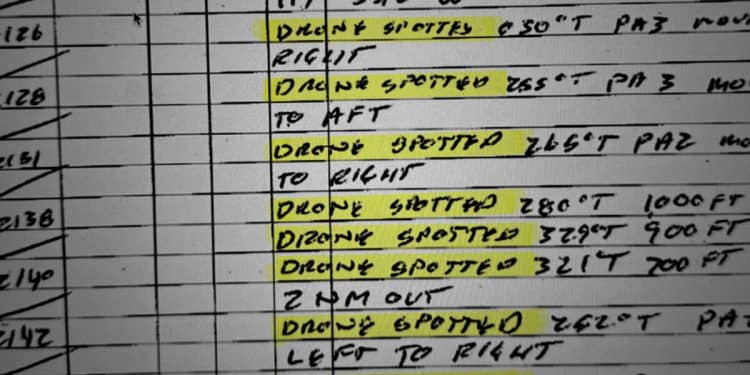Bill Whitaker, 60 Minutes correspondent, reports this week on Drone incursions which have been piercing the skies over significant military and infrastructure site around the United States for the past six years. 60 Minutes interviewed three four-star Generals, a member of Congress and a Biden White House official who all claimed to have no idea where or how the aircraft were coming from.
Gen. Glen VanHerck said, “We should be worried that we don’t know what they are,” the former head of NORAD and NORTHCOM – the agencies responsible for protecting U.S. aviation. “The question is, ‘Why do we not know what they are?’ You’ll find that there are some gaps, including in terms of capability, policy and law.
In December 2023, dozens of unmanned aerial systems (UAS) – as the military calls them – invaded the skies over Langley Air Force Base, Virginia, for 17 nights. These incursions became so frequent that the Air Force had to move some F-22s from Langley Air Force Base to another nearby base in order to protect them.
Langley was not the only military site to be swarming with drones in recent months. In 2019, drones shadowed warships that were training off the California coast. The War Zone, a defense news website, has since documented dozens similar intrusions on sensitive military and civil installations. These include the Palo Verde Nuclear Plant in Arizona, and the U.S. Air Force’s secretive, southern California-based Plant 42, where defense contractors build the next generation stealth bombers.
In New Jersey, the Army confirmed that 11 drones were spotted late last year in Picatinny. This is where advanced weapons are designed and built. This was followed by numerous drone sightings in New Jersey during the weeks that followed.
Why has it been difficult to stop drones that have made so many incursions in sensitive military areas?
Modern drones are a part of the answer. Drones are everywhere today, and they can be found in the hands of both Americans and their enemies. Some sophisticated drones are available on the Internet for just a few thousand bucks. They can hover or fly for up to ten hours and carry a 30 pound payload.
The aircraft can also be modified so that they fly at very high or low heights, which are impossible to track by the radars of the Federal Aviation Administration or NORAD.
VanHerck said to Whitaker that it was difficult if you couldn’t track and detect the aircraft, or identify whether they were civilian.
Shooting drones down
VanHerck explained that even if it is determined that the drones do not carry civilians, stopping them over the mainland America would not be as simple as knocking them from the sky as the U.S. Military might do in a foreign battlefield.
VanHerck said, “People who call for shooting them down over very populated regions need to understand that fighters, land-based missiles, or missiles launched from ships will accelerate up to two or four times faster than the sound, and that the warhead will have titanium rods that explode at thousands of feet per seconds.” “So, that’s also not safe.”
The debris field in a neighborhood could also pose a safety risk, as pieces of a drone and missile that weigh up to several hundred pounds are likely to be scattered.
Second, there is the issue of jurisdiction. What organization would be responsible for the downing of drones? Numerous entities could be involved depending on the location of an incursion, including local law-enforcement, the FBI and FAA as well as the Departments of Defense and Homeland Security.
“I think we’d be better off if we had a single organization that is resourced, empowered and tasked to solve this problem for our nation,” said retired Air Force general Mark Kelly. He was the highest ranking official at Langley Air Force Base when the drone invasion occurred there in December 2023.
Jamming drone frequencies
There are a few ways to jam drones’ communication frequencies.
Commercial drones are typically operated on radio frequencies of 2.4 GHz and 5.8 GHz, which are also the same bands used by Wi-Fi, wireless networks and applications, and video systems. Kelly explained that jamming these frequencies would knock out all services in the area.
In a similar way, the military can deny PNT, or precision timing and navigation, which most people refer to as GPS. Kelly says that denying the military’s PNT service, which is what most people think of as GPS, also removes navigational abilities from civilians and commercial pilots.
VanHerck admits that blocking drone communications is a complex task. He said that if you jam these frequencies and they are in spectrums for television, transportation, such as planes, you will have interference. “And this is the concern with using the electromagnetic spectrum.”
VanHerck said that the military could issue a “Notice to Airmen” which would warn commercial airlines to avoid a certain area as the military jammed frequency. He revealed, for the first, that the FAA had approved and coordinated an attempt to jam frequency during the incursion in Langley. NASA and Coast Guard resources were used. This effort was unsuccessful.
VanHerck stated, “I am not aware of any successes that they have had.”
Fly-away kit to stop future incursions
The military is working on flyaway kits to combat drone incursions. These are pre-packaged bundles that contain technology and can be used at different military bases when drones continue to invade. These kits will contain systems that allow the military see low-flying aircraft, which are missed by radars today.
The current commander of NORAD/NORTHCOM, Gen. Gregory Guillot said, “We could respond quickly with equipment and the authority to use that equipment in order to defeat this incursion.”
Guillot stated that flyaway kits would eventually include equipment capable of bringing drones down. He estimated that they would be ready for distribution within a year. If an attack like the one that occurred at Langley Air Force Base in 2026 were to occur again, the military could respond.
Guillot stated, “That’s what I want.” “We’re on the right track, working with industry partners to achieve this goal.”
Videos featuring drones, courtesy of Jonathan Butner & Paul Gerke.
Brit McCandless and Scott Rosann edited the video.









